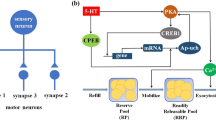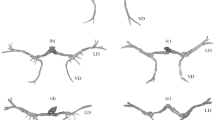Abstract
We examined changes in the ultrastructure of afferent mixed synapses on the membrane of Mauthner neurons (M cells) of the goldfish, which were related to two functional states, long-term potentiation (LTP) of the electrotonic response (a model form of the memory trace) and adaptation (resistivity to fatigue resulting from long-lasting motor training and considered a natural form of the memory trace manifested on the neuronal level). LTP was induced in medullary slices using high-frequency electrical stimulation of the afferent input. Adaptation was produced using natural vestibular stimulation (everyday motor training, which modified motor behavior of the fish and function of the M cell). It was supposed that if the LTP phenomenon is involved in the formation of natural memory, both the adaptation and the LTP states should be accompanied by similar specific structural modifications. Indeed, it was found that in both cases the number of fibrillar bridges in the gaps of desmosome-like contacts (DLC) in the mixed synapses on the M cell surface demonstrated an about twofold increase. These bridges are known to include actin filaments, which function as conductors of cationic signals; thus, the LTP-related increase in the density of bridges corresponds to increased efficacy of electrotonic coupling via mixed synapses. Such a structural correlate of LTP, which probably has the same functional significance in mixed synapses of the “adapted” M cells, allows us to suppose that LTP is a natural property of the nervous system. The LTP-type intensification of the relay function of mixed synapses, which corresponds to adaptation, is probably a compensatory rearrangement allowing M cells to maintain some balance of the synaptic influences and, at the same time, to remain in a stable and plastic state; this is necessary for stable functioning under changing environmental conditions.
Similar content being viewed by others
REFERENCES
C. Stevens, “A million dollar question: does LTP = memory?” Neuron, 20, No. 1, 1–2 (1998).
A. G. Bragin and O. S. Vinogradova, “A phenomenon of long-term potentiation in the cortical afferent input of pyramides in field TICA3of the hippocampus,” in: Physiological Mechanisms of Memory[in Russian], E. A. Gromova (ed.), ONTI NTSBI, Pushchino (1973), pp. 8–25.
T. V. P. Bliss and T. Lomo, “Long-lasting potentiation of synaptic transmission in the anaesthetized rabbit following stimulation of the perforant path,” J.Physiol., 232, No. 2, 331–356 (1973).
I. I. Abramets, “Neurochemical mechanisms of main forms of long-term depression of transmission,” Neirofiziologiya/ Neurophysiology, 32, No. 6, 463–472 (2000).
M. Baudry, Advances in Synaptic Plasticity, MIT Press, Cambridge, New York (2000).
V. Yu. Bol'shakov, “Mechanisms of long-term synaptic depression in the hippocampus,” Ross. Fiziol. Zh., 87, No. 4, 441–447 (2001).
O. S. Vinogradova, “Neuroscience at the end of the second millennium: A change of the paradigms,” Zh.Vyssh.Nerv. Deyat., 50, Issue. 5, 743–774 (2000).
C. H. Bailey, “Structural changes and the storage of longterm memory in Aplysia,” Can. J. Physiol. Pharmacol., 77, No. 9 738–747 (1999).
A. M. Thomson, “Facilitation, augmentation and potentiation at central synapses,” Trends Neurosci., 23, No. 7, 305–312 (2000).
J. D. Macklis, “New memories from new neurons,” Nature, 396, No. 6709, 414–415 (1998).
D. A. Moshkov, Adaptation and Ultrastructure of the Neuron[in Russian], Nauka, Moscow (1985).
X.-D. Yang and D. S. Faber, “Long-term potentiation of electrotonic coupling at mixed synapses,” Nature, 348, No. 6301, 542–545 (1990).
X.-D. Yang, H. Korn, and D. S. Faber, “Initial synaptic efficacy influences induction and expression of long-term changes in transmission,” Proc.Natl.Acad.Sci.USA, 88, No. 10,4299–4303 (1991).
L. L. Pavlik, N. R. Tiras, P. I. Pakhotin, et al., “Induction and long-term preservation of potentiation of electrical responses of Mauthner neurons of the goldfish in fragments of the medulla incubated in vitro,” Tsitologiya, 39, No. 7, 541–545 (1997).
L. L. Pavlik, N. R. Tiras, I. D. Pakhotina, and D. A. Moshkov, “Effect of cytochalasin D on the structure of mixed synapses and their electrical conductivity,” Tsitologiya, 41, No. 7, 590–597 (1999).
D. A. Moshkov, N. F. Mukhtasimova, L. L. Pavlik, et al., “n vitrolong-term potentiation of electrotonic responses of goldfish Mauthner cells is accompanied by ultarstructural changes at afferent mixed synapses,” Neuroscience, 88, No. 3, 591–605 (1998).
P. Faure, D. Kaplan, and H. Korn, “Synaptic efficacy and the transmission of complex firing pattern between neurons,” J.Neurophysiol., 84, No. 6, 3010–3025 (2000).
Y. Oda, K. Kawasaki, M. Morita, et al., “Inhibitory long-term potentiation underlies auditory conditioning of goldfish escape behavior,” Nature, 394, No. 6689, 182–185 (1998).
N. R. Tiras, I. B. Mikheeva, D. A. Moshkov, and P. I. Pakhotin, “Morphofunctional studies of adapted Mauthner neurons of the goldfish under conditions of long-lasting incubation of the medulla,” Morfologiya, 122, No. 6, 19–24 (2002).
J. G. Canfield and G. J. Rose, “Activation of Mauthner neurons during prey capture,” J.Comp.Physiol., Ser.A, 172, No. 7, 611–618 (1993).
D. A. Moshkov, N. R. Tiras, D. A. Dzeban, et al., “Structural differences between desmosome-like contacts in the afferent clinical and mixed synapses of Mauthner neurons of the goldfish,” Morfologiya, 120, No. 4, 30–35 (2001).
I. B. Mikheeva, N. R. Tiras, D. A. Moshkov, et al., “Desmosome-like contacts as a target for the action of scorpion venom,” Tsitologiya, 42, No. 7, 635–646 (2000).
N. A. Tushmalova and I. B. Marakuyeva, Comparative Physiological Study of Ultrastructural Aspects of Memory[in Russian], Nauka, Moscow (1986).
J. Diamond, “The Mauthner cell,” in: Fish Physiology, W. S. Hoar and D. J. Randall (eds.), Academic Press, New York (1971), pp. 265–346.
Yu. Konorski, Integrative Activity of the Brain[Russian translation], Mir, Moscow (1970).
E. N. Bezgina, T. M. Drabkina, S. N. Zemskova, et al., “Peculiarities of the temporal course of miniature end-plate currents in different regions of the neuromuscular junction in the frog,” Neirofi ziologiya, 19, No. 6, 779–789 (1987).
L. A. Kashapova, D. A. Moshkov, and E. N. Bezgina, “Active zones and plasticity of motor nerve terminals,” in: Restorative Neurobiology, Vol. 5, Chap. 17, A. Wernig (ed.), Elsevier Science Publ. (1991), pp. 163–173.
C. H. Baily and M. Chen, “Morphological basis of longterm habituation and sensitization in Aplysia,” Science, 220, No. 4598, 91–93 (1983).
P. A. Grigoriev, Yu. S. Tarahovsky, L. L. Pavlik, et al., “Study of actin interaction with planar and liposomal bilayer phospholipid membranes,” IUBMB Life, 50, No. 3, 227–233 (2000).
E. C. Lin and H. F. Cantiello, “A novel method to study the electrodynamic behavior of actin filaments. Evidence for cable-like properties of actin,” Biophys.J., 65, No. 4, 1371–1378 (1993).
L L. Pavlik, N. R. Tiras, N. F. Mukhtasimova, et al., “Involvement of actin in the electrotonic conduction through mixed synapses of Mauthner neurons of the goldfish,” Morfologiya, 123, No. 1, 41–45 (2003).
L L. Pavlik, N. F. Mukhtasimova, E. N. E. N. Bezgina, et al., “Ultrastructure of mixed synapses upon modification of the efficiency of synaptic transmission,” in: Problems of Neurocybernetics, B. M. Vladimirskii (ed.), Part 2, ??? “TsVVR,” Rostov-on-Don (2002), pp. 273–274.
D. A. Moshkov, N. R. Tiras, and M. E. Saxon, “Phalloidin changes the synaptic contacts ultrastructure,” Naturwissenschaften, 67, No. 4, 194–195 (1980).
D. A. Moshkov, N. R. Tiras, and V. V. Potyemkin, Effects of phalloidin and long-term sensory stimulation on ultrastructure of Mauthner neurons of the goldfish,” Tsitologiya, 26, No. 12, 1351–1356 (1984).
S. Royer and D. Pare, “Conservation of total synaptic weight through balanced synaptic depression and potentiation,” Nature, 422, No. 6931, 518–522 (2003).
L. E. Abbott and S. B. Nelson, “Synaptic plasticity: taming the best,” Nat.Neurosci., 10, No. 3, 1178–1183 (2003).
Author information
Authors and Affiliations
Corresponding author
Rights and permissions
About this article
Cite this article
Moshkov, D.A., Pavlik, L.L., Tiras, N.R. et al. Ultrastructural Changes in the Mixed Synapses of Mauthner Neurons Related to Long-Term Potentiation and Natural Modification of the Motor Function. Neurophysiology 35, 361–370 (2003). https://doi.org/10.1023/B:NEPH.0000015566.00524.a6
Issue Date:
DOI: https://doi.org/10.1023/B:NEPH.0000015566.00524.a6




